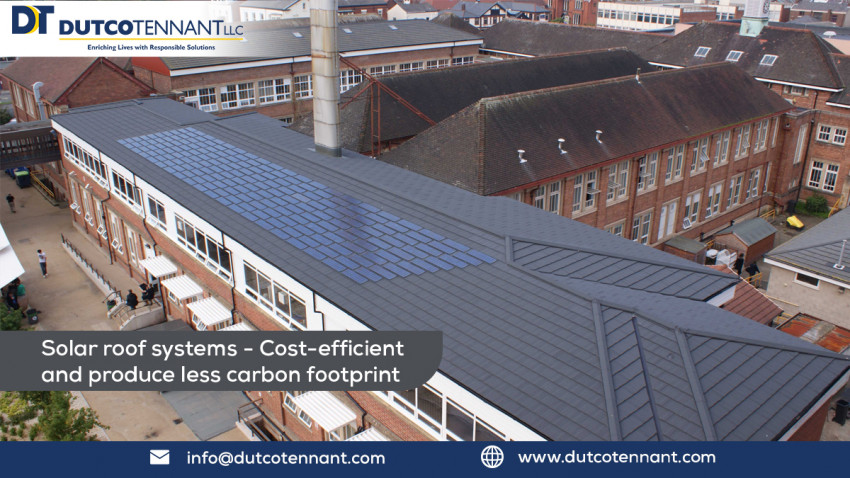
The demand for varied types of solar power systems have increased over the decades mainly due to the growing popularity of solar energy. There are essentially three types of solar roof systems and they are - on-grid solar rooftop system, off-grid solar rooftop system and hybrid solar rooftop system.
Industries around the globe are investing in sustainable energy for all the right reasons and harnessing the power of the sun with the help of high-quality solar rooftop systems is the perfect solution. But there are an array of things involved when it comes to setting up a high-efficiency solar rooftop system.
Keep reading till the end to learn all things essential about the rooftop solar system.
Required Components for Solar Rooftop System
There are a handful of basic component requirements in order to set up efficient solar rooftop system and they are -
Solar Photovoltaic (PV) Panels
Solar PV panels are key components of rooftop solar systems as they help in forming maximum efficiency solar arrays when they are wired together. Typically, solar panels are available in the power capacity range of 40 Wp to 390 Wp, but it can go above based on the application for which they’ll be used. The panels are used to develop arrays that are suitable with the solar plant’s capacity.
Solar Power System Inverter
This component is essential if you are setting up a solar rooftop system for household applications and assuming that the appliances run on AC whereas the solar panels generate DC. This raises the need for a solar power system inverter to deliver usable 220V AC, 240V AC, or 115V AC. Experts suggest that users should prefer using lightweight inverters along with in-built charge controllers and remote control capabilities.
Battery Charge Controller
Now a majority of solar roof systems come equipped with a battery backup system powered by a diesel-run generator, wind turbine or an inverter that would help in preparing for nights or cloudy days or for days with no or dull sunlight. The battery charge controller is an inexpensive component nevertheless critical for the solar rooftop system. It helps in preventing the batteries from getting overcharged and keeps the backup batteries from discharging out during the night.
Solar Power System Disconnects
This one is basically an electric switch that plays a key role in a rooftop solar system. With the help of this switch, users are able to turn off the DC supply from the system in case of carrying out repair or clearing operations.
Deep Cycle Batteries
This component may not be seen in all rooftop solar systems but with its use, one can definitely ensure that the operations keep running all throughout the day irrespective of the sunlight amount the panels get.
Solar Power Meter
This piece of component might not be compulsory for every rooftop solar system but they are essentially used for calculating how much money these rooftop solar system components are saving. Most importantly, with the use of solar power meters, users can get valuable insights to boost the overall system installation efficiency and reach its full capacity.
Types of Solar Rooftop Systems
Now let's take at some of the different types of rooftop solar systems that are available in the market. These are -
On-grid Systems
In this type, the rooftop solar system is integrated with the main grid supply. Here the power is enabled to be used from only the grid supply when the rooftop system is not capable of the supply needed power capacity. Hence, this type of system ensures saving expenses when they are well-planned. In fact, as any excess power generated that can be fed to the grid resulting in DISCOMs paying compensation by utilizing net metering, this system can earn revenues the same.
Off-grid Systems
As the name suggests, this type of rooftop solar system is not connected to the main grid system. Instead, it has the capacity to run on its own battery. The solar energy produced from the solar rooftop system allows the battery to get charged which is then utilized for powering various applications. This system is specifically beneficial where there is unavailability of any grid supply or when the supply tends to be erratic with breakdowns happening too frequently.
Hybrid Systems
The hybrid systems run on both on-grid and off-grid operations. Even though the use of batteries is present in this system, the perk of it is that after the battery is completely charged the excessive power produced is fed to the grid which helps the consumers to generate additional revenues.
Significant Considerations for the Feasibility of Rooftop Solar Systems
The following considerations are strictly for home rooftop solar systems. In order to consider the system’s feasibility, the nature of the roof needs to be determined essentially. Some of the factors that are needed to be considered are -
· The availability of sunlight annually received along with the rooftop area available are needed to be calculated for determining the power generated from the system. A common home solar panel has the capacity to generate 290 watts of power supply from harnessing an hour of sunlight directly.
· The decision making for selecting the most suitable type of solar system greatly influences the overall cost of the system. Each type of rooftop solar system has a requirement for different components and based on that the costs can vary greatly as well.
If you want more insight on solar roof systems then make sure to get in touch with expert suppliers dealing with this solution.



